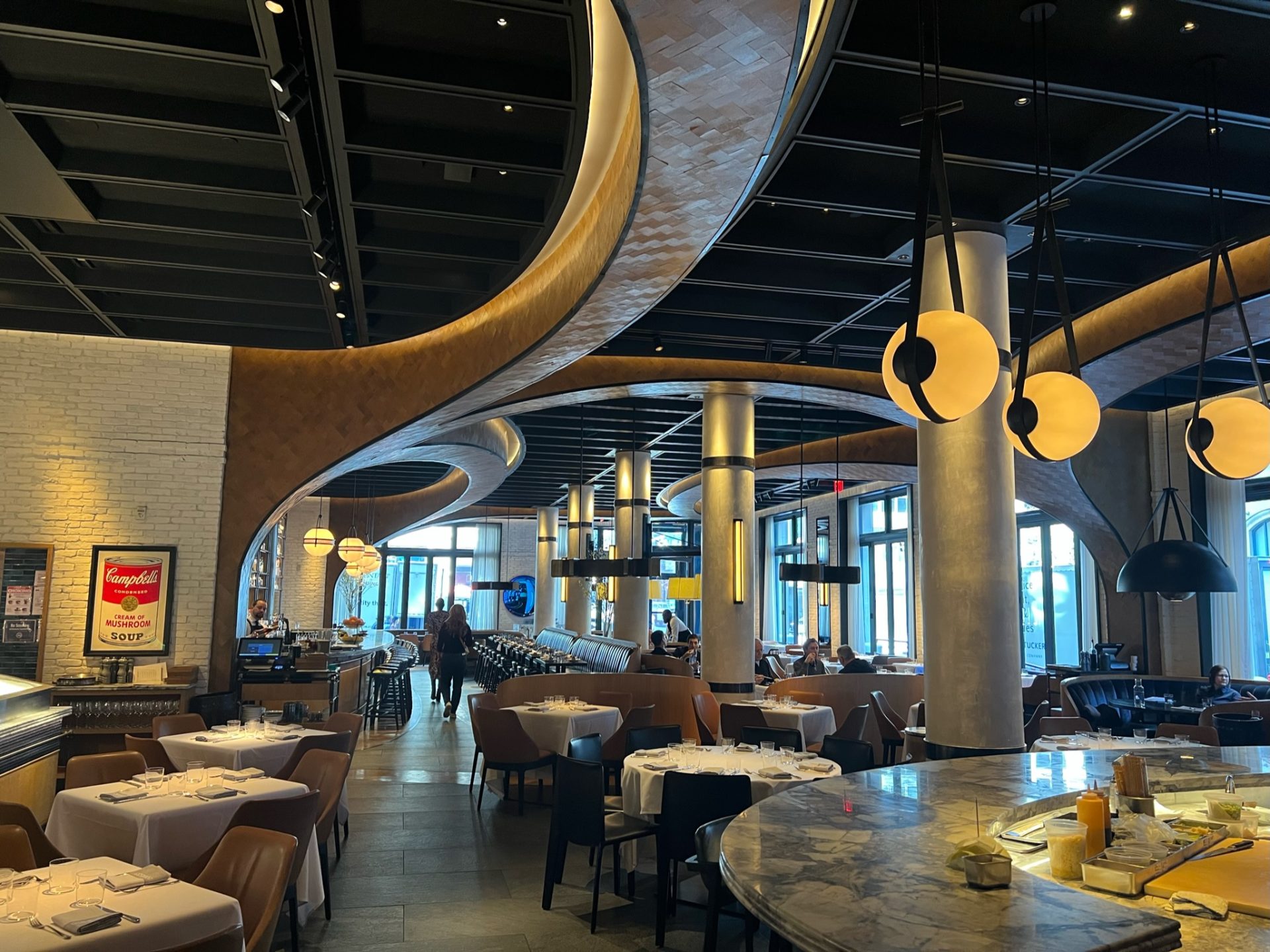Savor Genuine Asian Cuisine With a Pan-Asian Twist for a Cooking Journey
Embarking on a culinary journey with authentic Eastern cuisine, enhanced with a Pan-Asian twist, offers a distinct possibility to explore the abundant tapestry of flavors that define the area's diverse cooking customs. This experience welcomes you to appreciate the splendid equilibrium of tastes-- sweet, salty, spicy, and sour-- harmonized by fragrant natural herbs and flavors. Picture the innovative fusion of Thai curry and ramen or the unanticipated delight of sushi burritos. As you contemplate these tempting recipes, think about the cultural narratives and historic impacts that form them, each bite supplying a story waiting to be found.

Exploring Pan-Asian Flavors
In the realm of international gastronomy, Pan-Asian food stands out for its impressive diversity and the unified interplay of flavors from numerous Asian societies. This cooking method commemorates the rich customs and one-of-a-kind components found across the continent, producing a tapestry of preferences that is both rewarding and appealing. Trick to Pan-Asian cuisine is its capability to stabilize different tastes-- sweet, salty, spicy, and sour-- while highlighting the freshness and quality of each active ingredient.
From the umami-rich soy sauce of Japan to the fiery chili peppers of Thailand, Pan-Asian cuisine provides a considerable palette of flavors. These aspects are commonly incorporated in inventive ways, enhancing meals with layers of complexity. For example, making use of great smelling natural herbs such as lemongrass and cilantro, usual in Vietnamese and Thai food, includes a revitalizing brightness to dishes, while the incorporation of coconut milk delivers a creamy, rich structure.
The focus on fresh fruit and vegetables and fragrant flavors guarantees that each meal is not only a banquet for the taste buds yet likewise for the detects. Pan-Asian food welcomes restaurants to start a cooking journey, checking out the huge and varied landscapes of Asian gastronomy with every bite.
Fusion Dishes to Attempt
While Pan-Asian cuisine is commemorated for its conventional tastes, the modern cooking landscape is increasingly accepting blend meals that mix these classic aspects with influences from other areas. This innovative technique not only honors the rich heritage of Eastern cookeries however additionally introduces novel preference experiences that appeal to contemporary tastes buds.
A prime example of such a combination meal is the Korean-Mexican taco, where seasoned bulgogi beef is wrapped in a warm tortilla, covered with kimchi and a zesty gochujang-infused salsa. This combination marries the strong, savory flavors of Korea with the vibrant, fresh aspects of Mexican food. In a similar way, sushi burritos have gotten appeal, amalgamating the delicate artistry of Japanese sushi with the passionate, hand-held benefit of a burrito, usually featuring combination ingredients like tempura shrimp and avocado with a drizzle of wasabi mayo.
One more notable recipe is Thai curry ramen, which instills the creamy, aromatic spices of Thai curry into the reassuring brew of standard Japanese ramen, developing an unified mix that entices the detects. These fusion dishes extend beyond simple novelty; they represent a culinary dialogue between cultures, motivating expedition and advancement worldwide of Pan-Asian food.
Crucial Ingredients and Spices
To truly value Pan-Asian food, one have to recognize the essential ingredients and spices that develop its structure. This varied cooking style draws from an abundant tapestry of Eastern practices, utilizing a harmonious blend of appearances and tastes. Secret components include soy sauce, fish sauce, and oyster sauce, which impart a savory umami deepness crucial to Oriental meals. Complementary to these check out here are rice vinegar and mirin, offering a fragile acidity and sweetness.
Aromatic elements are crucial, with garlic, lemongrass, and ginger read here being common across numerous Pan-Asian recipes. These active ingredients supply a fragrant base that boosts the complexity of tastes. Spices such as celebrity anise, cardamom, and cinnamon introduce warmth and personality, echoing impacts from regions like China and India.

Food Preparation Strategies and Tips
Mastering the art of Pan-Asian cuisine requires experience with its distinctive food preparation strategies, each adding to the vibrant tapestry of flavors this culinary custom is celebrated for. Central to these techniques is the stir-fry, a fast food preparation method that protects the dietary honesty and dazzling colors of components. Making use of a frying pan, the stir-fry approach enables also warmth distribution, necessary for attaining the particular appearance and taste balance of Pan-Asian recipes.
An additional basic strategy is steaming, specifically widespread in Chinese food. This mild technique maintains the natural flavors and nutrients of components, making it optimal for seafood and vegetables. Dumplings, a beloved staple, often take advantage of steaming, causing soft, delicious structures.
Barbecuing, also integral, presents great smoky depths to dishes such as Korean bulgogi or Japanese yakitori (asian restaurant isb). This strategy usually includes marinating ingredients, allowing tastes to penetrate deeply before food preparation over an open flame or warmer
Finally, understanding the art of balancing tastes-- wonderful, sour, salty, bitter, and umami-- is critical. Appropriately layering these elements can boost a meal from ordinary to phenomenal, providing a complex and pleasing cooking experience that symbolizes the significance of Pan-Asian cuisine.
Eating Experiences Worldwide
Throughout the globe, Pan-Asian food provides an exceptional dining experience, celebrated for its abundant tapestry of flavors and vivid presentations. This cooking phenomenon has actually transcended cultural borders, catching the hearts this article and palates of food lovers worldwide. In cosmopolitan cities fresh York, London, and Sydney, Pan-Asian dining establishments work as melting pots where culinary practices from Thailand, Japan, China, and beyond assemble, giving diners with an eclectic mix of dishes that highlight the region's variety.
The international allure of Pan-Asian food depends on its ability to offer both authenticity and development. Chefs skillfully marry standard components such as lemongrass, soy sauce, and miso with modern methods, causing meals that are both refreshingly new and familiar. This blend enables restaurants to begin on a culinary journey that respects heritage while welcoming modernity.
In addition, eating experiences are raised with thoughtfully developed environments that reflect the ethos of Pan-Asian looks. From minimal Japanese-inspired interiors to dynamic Thai-themed spaces, each restaurant offers a distinct setting that matches the culinary offerings. As an outcome, clients are not just taking in a meal but partaking in a social experience, making Pan-Asian eating a really global sensation.
Verdict
The exploration of Pan-Asian cuisine supplies an extensive understanding of the elaborate interplay of tastes and culinary traditions throughout Asia. By accepting fusion dishes such as Thai curry ramen and sushi burritos, the cooking journey not just highlights the versatility of conventional active ingredients however also showcases cutting-edge contemporary techniques. This gastronomic journey, enhanced by cooking approaches and necessary spices, gives a distinct opportunity to appreciate the social diversity and cooking creativity that specify Pan-Asian cuisine on an international scale.
Getting started on a culinary trip through genuine Oriental food, boosted with a Pan-Asian twist, uses a distinct opportunity to discover the rich tapestry of tastes that define the region's varied cooking customs.In the world of global gastronomy, Pan-Asian cuisine stands out for its impressive diversity and the unified interaction of flavors from different Eastern cultures. Secret to Pan-Asian food is its ability to balance different flavors-- sweet, salted, spicy, and sour-- while highlighting the quality and quality of each active ingredient.
